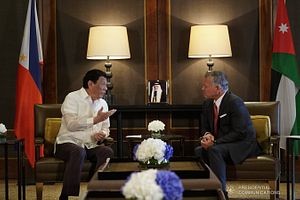From September 5 to 7, Rodrigo Duterte paid the first visit by a sitting Philippine president to Jordan. While the trip was part of a broader voyage to the Middle East and both sides addressed a range of issues during the visit, defense ties was one of the key talking points, with headlines focused around Jordan’s expected transfer of attack helicopters to the Philippines.
While the Philippines and Jordan have had a diplomatic relationship since 1976, ties have remained largely underdeveloped and often consumed by challenges such as the management of Philippine domestic workers in the Middle Eastern country. Within that context, the defense side of the relationship has remained below its potential as well, despite growing convergence on issues such as counterterrorism.
Duterte’s visit to Jordan, which came following a trip to Israel, put a spotlight on the defense side of the relationship. While both countries discussed a range of political, economic, and people-to-people issues, defense matters were top of the list as well: both leaders unsurprisingly placed attention on the shared threat of terrorism, and one of the main agreements both sides inked during Duterte’s visit was a new memorandum of understanding on defense cooperation between the Philippines Department of National Defense (DND) and the Jordan Armed Forces-Arab Army.
But the main focus of the media headlines around defense issues during the visit centered around the Jordanian government’s provision of two Bell AH-1 Cobra attack helicopters to the Philippines. Though the potential transfer had been in the works since last year, doubts had lingered on its specifics, including the timeline and number of helicopters. But during the visit, Special Assistant to the President Christopher “Bong” Go confirmed the deal and said that the helicopters are expected to be delivered around next July, following the training of Philippine pilots.
Should the transfer of the helicopters take place as scheduled, it would be significant. While these are used helicopters, they would nonetheless constitute a much-needed addition to the Philippines’ currently limited military capabilities. Philippine defense spokesperson Arsenio Andolong told the Philippine News Agency that the helicopters would be useful for addressing several security challenges, including the ongoing campaign against terrorism and violent extremism.
And though it is still unclear what the Philippines will be paying for in the transfer of the helicopters – in terms of things such as shipping and refurbishment costs – it could potentially free up some money for Manila to pursue other line items in the shopping list it has for its broader military modernization process.
Lastly, it is also worth noting that beyond this one deal itself, its success, along with the boost that we have seen in defense ties thus far, could also pave the way for further deals in the future as well. Christopher “Bong” Go has already noted that other military equipment would be included, including mortars, rifles, and rocket-propelled grenades (RPGs). And while he did specify that no deals had been agreed to yet, he indicated that Manila may consider the possibility of buying other military equipment from Jordan and Israel as well.































